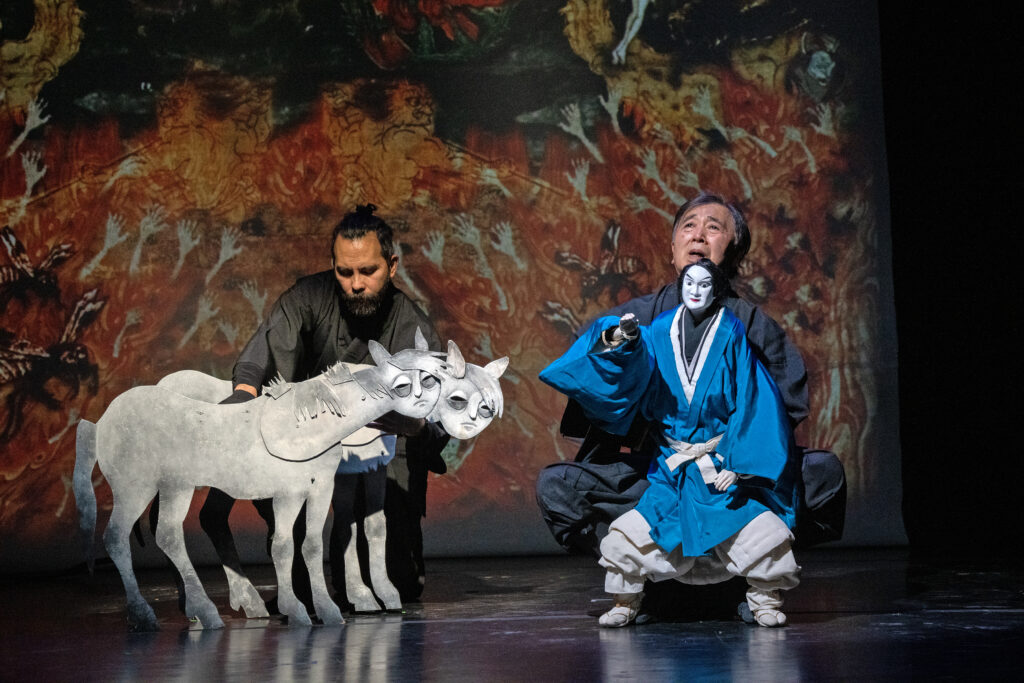How did the ArtsCONNECT grant support Japan Society’s mission?
Japan Society’s generous grant support from ArtsCONNECT allowed us to support Tom Lee and Koryu Nishikawa V’s tour of our program, AKUTAGAWA, in the Mid-Atlantic region. Thanks to the tour, we were able strengthen our partnerships with Virginia Tech and The Japan-America Society of Pennsylvania, and by extension the University of Pittsburg, where the show was presented in PA. Due to the strong attendance at both universities, in the future, we hope to work with these institutions again to present Japanese performing arts.
Despite the thousand-year history of Japanese puppetry, traditional techniques have only gained recognition in the US over the past 25 years. As the first presenter of Kuruma Ningyo in the United States in 2003 (and again in 2019), we are thrilled to partner with organizations that are helping to spread awareness about this rare and unique form of puppetry. Accomplishing wider regional reach via the tour would not have been possible without MAAF’s generous support.
What are some highlights from the public performances of AKUTAGAWA, the puppetry masterclass, and the family puppetry workshop? What were your goals for each grant activity?
Our major goals for this programming were to increase U.S. audience exposure to both the iconic Japanese novelist Akutagawa and Kuruma Ningyo puppetry, so we are pleased to report that all three of our public performances of AKUTAGAWA were sold out, as was the puppetry masterclass with the artists.
The masterclass was so popular we ended up selling “observer” tickets for individuals who wanted to sit in on the class even though there weren’t enough puppets for them to participate in the hands-on lesson. Furthermore, in our family workshop, half of our participants were young people, so we felt we furthered our goal of bringing this richly historied artform to the younger generation.
Many members of our audience remarked that they had never seen a performance quite like it and that they wished to learn more or delve deeper into the literary context.
One audience member said, “Following the recommendations, I will read the stories of Ryunosuke Akutagawa and hope it will bring back the images of this wonderful evening. I am very grateful that the Japan Society provides experiences like last night.”
Another, “I am a high school English teacher, and I think this performance could be great in the schools for 11th and 12th graders. The literary elements and the bunraku are a great combination.”

Display caption
Photo: Scenes from AKUTAGAWA’s short story “Hell Screen.” Credit: Richard Termine.
Tell me more about the partnership with local artist Tom Lee with the Hachiioji Kuruma Ningyo Puppet Company. Where did this program fit in with other programs? What was compelling about this collaboration?
Japan Society Performing Arts has long-standing relationships with Nishikawa and Lee. In March 2019, we presented a collection of women-focused stories from classic Japanese literature performed by Nishikawa and his company of Kuruma Ningyo puppeteers. We have also promoted past collaborations between Lee and Nishikawa, including SHANK’S MARE, and Lee’s work on The Met Opera’s latest production of MADAMA BUTTERFLY.
Our AKUTAGAWA program was presented as the third part of a slate of programming that season encompassing the life, death, and writings of iconic novelist Ryunosuke Akutagawa. First was the world premier of Japan Society-commissioned opera note to a friend by David Lang, about the writer’s life; and second was the 35mm film screening of Akira Kurosawa’s classic, Rashomon, based on Akutagawa’s In a Grove.
AKUTAGAWA portrayed the author’s life and psyche chronologically through several of his short story masterpieces—Rashomon, Hell Screen, The Dragon, Toshishun and Kappa. The puppets onstage represented both the characters from Akutagawa’s stories and the writer himself. For instance, one of the first scenes of the production is Akutagawa seated at his writing desk as he puts pen to paper. As he does so, Koryu Nishikawa enters and begins to assemble the body parts and costume of a puppet, exposing the technique of building a puppet structure that audiences usually never see. It was an exciting production that invited the audience to meditate deeply on themes of solitude – ever more important post-pandemic – and where life meets art.
If you could repeat this performance and workshop series, what would you do differently? What program or project do you have coming up in the fall that you are excited about?
Unlike most U.S. domestic artists’ tours, international tours — which are Japan Society’s specialty — have limited time for residency activities. Within such limitations, we tailor our ancillary and educational programming to certain audience types, depending on the type of artist. If we have an opportunity to invite Tom Lee and Koryu Nishikawa V again, we would like to do workshops tailored to professional performance artists because there are many rising young professional puppeteers in New York City — the appetite to learn their technique must be immense.
For the upcoming 2023-24 season, Japan Society has organized and produced a tour showcasing a traditional Nihon Buyo (i.e. Kabuki dance) group in January-February 2024. We will invite several classes from public schools in under-served communities in the morning and provide a special program, featuring a performance, lecture on the history of Kabuki dance, demonstration of traditional Japanese music instruments, and a hands-on dance workshop for families and children. Additionally, we will present a workshop open to the general public. The Kennedy Center in Washington, D.C., one of the venues for this tour, will conduct a master class for adult dance students.
